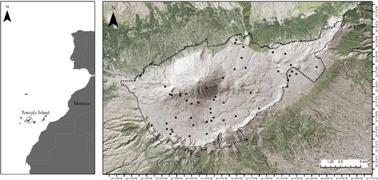Climate change causes rapid collapse of a keystone shrub from insular Alpine ecosystems |
| |
| Affiliation: | 1. Plant Conservation and Biogeography Research Group. Departamento de Botánica, Ecología y Fisiología Vegetal. Universidad de La Laguna. Avda. Francisco Sánchez s/n, 38200 Apdo. 456. La Laguna, Tenerife, Islas Canarias, Spain;2. Parque Nacional del Teide. C/Sixto Perera González 25, 38300 La Orotava, Tenerife, Islas Canarias, Spain;3. Consejería de Educación, Universidades, Cultura y Deportes. IES Vega de San Mateo. C/ Cuatro Caminos s/n. La Lechucilla, 35320 Las Palmas, Spain;4. Carretera General a Punta del Hidalgo 31, Tegueste, Tenerife, Islas Canarias, Spain |
| |
| Abstract: | 
Increasing species regression speeds are one of the consequences of global warming, which affect both rare and abundant species. However, long-term monitoring data are rarely available to understand the effects of global warming. Alpine ecosystems on islands are some of the most unique in terms of species composition around the world, with high proportions of endemics. Yet, they are some of the most threatened by climate change. In such areas, global warming causes the invasion of other species that move upwards from ecosystems at lower elevations, which exacerbates climate change impact on these areas. Obtaining fine-scale data on decline rates in keystone species in these areas is essential to understand the degradation processes underway in high mountain systems. This study uses historical aerial images to analyse at a fine-scale the rate of decline of a keystone endemic species, Spartocytisus supranubius (L. f.) Christ ex G. Kunkel, in Tenerife (Canary Islands). Fifty plots were randomly selected in Teide National Park to evaluate the area occupied by living individuals of this species using image segmentation techniques. We conclude that the dominant species in this area, S. supranubius, underwent a mean decline over 32 years between 28.7 and 41.0, depending on whether we consider the observed or interpolated data. Our results suggest that we are facing a possible collapse of the broom and allow us to propose listing this species as vulnerable, according to the IUCN criteria of threatened species. The regression in coverage was negatively correlated with temperature and positively with precipitation. |
| |
| Keywords: | Conservation Threatened species IUCN Image segmentation High mountain Global warming |
| 本文献已被 ScienceDirect 等数据库收录! |
|

